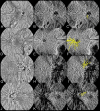A Novel Exploration of the Choroidal Vortex Vein System: Incidence and Characteristics of Posterior Vortex Veins in Healthy Eyes
- PMID: 38334703
- PMCID: PMC10860687
- DOI: 10.1167/iovs.65.2.21
A Novel Exploration of the Choroidal Vortex Vein System: Incidence and Characteristics of Posterior Vortex Veins in Healthy Eyes
Abstract
Purpose: The purpose of this study was to investigate the incidence and characteristics of posterior vortex veins (PVVs) in healthy eyes and explore their relationship with age and refractive status.
Methods: This retrospective cross-sectional analysis encompassed 510 eyes from 255 consecutive healthy participants. Wide-field optical coherence tomography angiography (WF-OCTA) imaging was used to assess the presence of PVVs. Eyes were classified according to refractive status (emmetropia, low and moderate myopia, and high myopia) and age (minors and adults). The incidence and characteristics of eyes with PVVs were analyzed.
Results: Participants (mean age = 30.60 ± 21.12 years, 47.4% men) showed a mean refractive error of -2.83 ± 3.10 diopters (D; range = -12.00 to +0.75). PVVs were observed in 16.1% (82/510) of eyes. Of these, 39% (32/82) had PVVs in one eye and 61% (50/82) in both eyes. The mean number of PVVs per eye was 1.65 ± 1.05 (range = 1-6). PVVs are mainly around the optic disc (78%, 64/82) of eyes with PVVs and less in the macular area (6.1%, 5/82) or elsewhere (15.9%, 13/82). PVV incidence correlated with refractive status: 10.3% (22/213) in emmetropia, 16.6% (31/187) in low and moderate myopia, and 26.4% (29/110) in high myopia (P = 0.001), but not with age. Refractive status was the key predictor of PVV occurrence (odds ratio [OR] = 1.45, 95% confidence interval [CI] = 1.02-2.06, P = 0.038).
Conclusions: This study confirms PVVs' presence in healthy eyes, highlighting their inherent existence and susceptibility to alterations due to refractive conditions. These findings enhance our understanding of the vortex vein system and its distribution within the eyes.
Conflict of interest statement
Disclosure:
Figures





Similar articles
-
Detection of posterior vortex veins in eyes with pathologic myopia by ultra-widefield indocyanine green angiography.Br J Ophthalmol. 2017 Sep;101(9):1179-1184. doi: 10.1136/bjophthalmol-2016-309877. Epub 2017 Jan 18. Br J Ophthalmol. 2017. PMID: 28100480
-
Choroidal Thickness Variation According to Refractive Error Measured by Spectral Domain-optical Coherence Tomography in Korean Children.Korean J Ophthalmol. 2017 Apr;31(2):151-158. doi: 10.3341/kjo.2017.31.2.151. Epub 2017 Mar 21. Korean J Ophthalmol. 2017. PMID: 28367044 Free PMC article.
-
[Analysis of the correlation between peripapillary retinal nerve fiber layer cross-sectional area and myopia in individuals aged 50 years and above].Zhonghua Yan Ke Za Zhi. 2023 Jul 11;59(7):550-556. doi: 10.3760/cma.j.cn112142-20221227-00660. Zhonghua Yan Ke Za Zhi. 2023. PMID: 37408426 Chinese.
-
Characterization of Choroidal Morphologic and Vascular Features in Young Men With High Myopia Using Spectral-Domain Optical Coherence Tomography.Am J Ophthalmol. 2017 May;177:27-33. doi: 10.1016/j.ajo.2017.02.001. Epub 2017 Feb 13. Am J Ophthalmol. 2017. PMID: 28209502
-
[A new approach for studying the retinal and choroidal circulation].Nippon Ganka Gakkai Zasshi. 2004 Dec;108(12):836-61; discussion 862. Nippon Ganka Gakkai Zasshi. 2004. PMID: 15656089 Review. Japanese.
Cited by
-
Whorl-Like Collagen Fiber Arrangement Around Emissary Canals in the Posterior Sclera.Invest Ophthalmol Vis Sci. 2025 Mar 3;66(3):35. doi: 10.1167/iovs.66.3.35. Invest Ophthalmol Vis Sci. 2025. PMID: 40100203 Free PMC article.
-
Automated Posterior Scleral Topography Assessment for Enhanced Staphyloma Visualization and Quantification With Improved Maculopathy Correlation.Transl Vis Sci Technol. 2024 Oct 1;13(10):41. doi: 10.1167/tvst.13.10.41. Transl Vis Sci Technol. 2024. PMID: 39476086 Free PMC article.
-
Association between inferior posterior staphyloma on choroidal vessels running patterns in healthy eyes.Int J Retina Vitreous. 2025 Mar 27;11(1):37. doi: 10.1186/s40942-025-00661-w. Int J Retina Vitreous. 2025. PMID: 40149010 Free PMC article.
References
-
- Hayreh SS, Hayreh SB.. Uveal vascular bed in health and disease: uveal vascular bed anatomy. Paper 1 of 2. Eye 2023. Available at: https://www.nature.com/articles/s41433-023-02416-z. Accessed May 22, 2023. - PMC - PubMed
-
- Yu D-Y, Yu PK, Cringle SJ, et al. .. Functional and morphological characteristics of the retinal and choroidal vasculature. Prog Retinal Eye Res. 2014; 40: 53–93. - PubMed
-
- Verma A, Maram J, Alagorie AR, et al. .. Distribution and location of vortex vein ampullae in healthy human eyes as assessed by ultra-widefield indocyanine green angiography. Ophthalmol Retina. 2020; 4: 530–534. - PubMed
-
- Lim MC, Bateman JB, Glasgow BJ.. Vortex vein exit sites. Ophthalmology. 1995; 102: 942–946. - PubMed
MeSH terms
LinkOut - more resources
Full Text Sources
Medical

